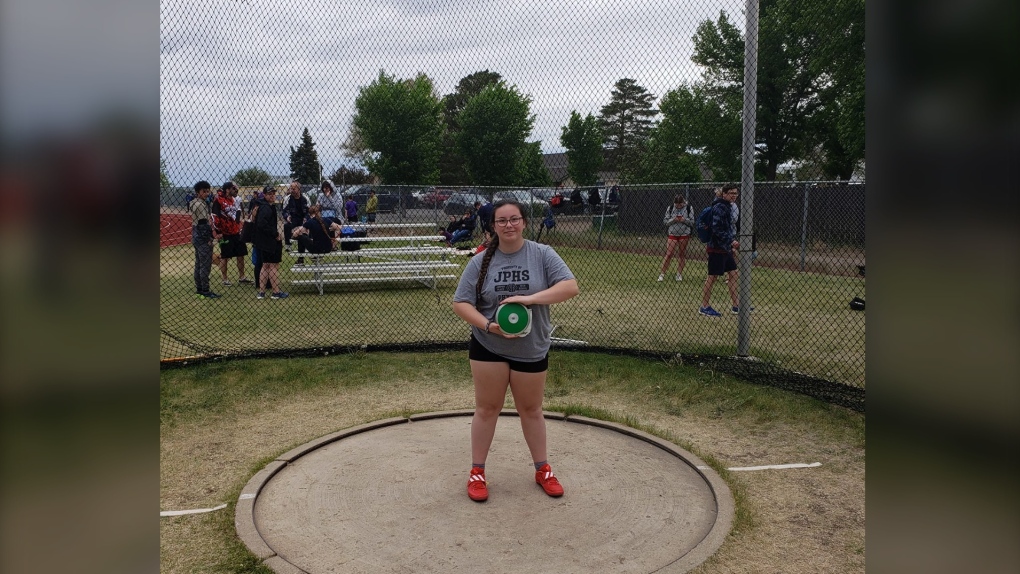“The fun of track meets, for me at least, has been lost as I’ve gotten older.”
For a decade of her life, Christina Hollingworth has been involved in track and field – a sport that involves running, high jump, throwing and overall athleticism.
From age six, her parents instilled in her the desire to practice and get better results, but to also have fun and enjoy the sport.
The Edmonton resident, now 16, still carries those values with her. She is ranked second in Canada for the discus throw, an event within track and field where participants throw a 2.2-pound disk.
Christina’s journey of getting to the top has been a lonely one.
She’s witnessed several friends drop out of track, unable to mentally or emotionally handle the pressure – and sometimes abuse and shame – that is placed on young women and girls in sport.
For the young Enoch Cree First Nation woman, watching so many talented athletes turn away from sports was heartbreaking.
“I’ve had to deal with some coaches that were fat shaming girls, and emotionally and mentally very taxing coaches,” Christina told CTVNews.ca in an interview.
“I’ve noticed with throwers, they will last for about two years, and then they leave. And I’ll never seen them again.”
The Canadian Women & Sport organization says 50 per cent of girls will drop out of sports in Canada by adolescence, due to the ongoing pressure from society and the lack of female leadership to lean on.
Christina Hollingworth is second in Canada for her age in discus. (Contributed)
And coming out of the pandemic, Christina says she is witnessing even fewer people, particularly girls and young women, playing sports.
She believes lockdowns impacted her peers. Even before the pandemic, women and girls were less likely to stay in sports; now, as COVID-19 no longer has the same impact on sports, trends show female athletes are not returning.
HOW COVID-19 IMPACTED WOMEN, GIRLS IN SPORT
A report by the Canadian Women & Sport organization, a Canadian non-profit advocating for equity in all sports, showcases that in a post-pandemic world, the number of girls and women participating in sports is low.
The “Rally Report” summarized a survey of 4,500 girls and women, and 350 sport leaders, about their experiences in sport in 2022.
What researchers found was the number of women and girls playing in sport over the pandemic held “steady,” but as years of disruptions come to an end, many female athletes are thinking of leaving for good.
“The fact that we did not lose large masses of girls and women over the pandemic is a huge victory,” the report states.
COVID-19 forced sports organizations to disband ahead of the summer of 2020 due to physical distancing requirements, leaving few options for people to participate in sports.
Researchers noted many girls and women found alternative activities to do when sport was cancelled. According to the Rally Report, one in three young adult women aged 13 to 18 who are in sports are unsure if they will continue, the 2022 statistics read.
And even with the report noting many female athletes stayed in sport, about 13 per cent of girls aged 13 to 18 and 10 per cent aged six to 12 who participated in sport before the pandemic did not return.
In a post-pandemic world, Christina noticed the track meets she used to love felt different.
“When you go and compete at these meets, it’s become very cliquey,” she said. “You either are friends with some people or you’re not, and if you’re not within this ‘it crowd’ of people who talk to each other. You’re very much an outcast.”
The pandemic played a role in shaping how young people saw the world, impacting their mental health and social skills. Like other teens, Christina was away from peers at school and track meets for two years.
Over the pandemic, parents reported 20 per cent of girls aged six to 12 are less interested in sport than before.
Despite the low number of dropouts from female athletes, the report notes overall participation of women and girls in sports across Canada is too low, especially when compared to men and boys of the same age.
Some of the reasons the report says women are less likely to be in sports have to do with barriers like racism, poverty, ageism and equity. The issues force girls like Christina to think about why they continue in sport even though the reward is minimal.
According to the data from the Rally Report, by adolescence, half of girls stop participating, and the numbers decrease the older women get, suggesting that as girls age, more barriers impact their abilities to participate in sports.
Opportunities to play or continue in sport as a career are impacted as women age due to less emphasis on continued participation from older women and a lack of role models in society.
Even female athletes playing in the Olympics have limited opportunities to create a financially stable path for themselves. Currently, the Canadian women’s gold-medal soccer team is fighting Canada Soccer for what it calls funding equity and pay.
SEXISM, ABUSE DISCOURAGES ATHLETES
Warning: This section contains references to suicide and disordered eating.
Seeing women excel in sports or be in positions of power within sport organizations have positive impacts on younger female athletes like Christina.
In her entire discus career, Christina can think of two times she had a female coach. When she was coached by women, Christina felt they understood her perspective.
“She made sure that I was getting training and trying to make sure I did better in the sport,” she said. “It was different in the sense that they understood more about being a girl in sports.”
For most of her time in track and field, she had what she described as mentally abusive male coaches.
One example of where female coaches might approach things differently is with the pressure on young athletes to be fast, throw the furthest or jump the highest, which sometimes results in girls not eating, Christina said.
Many times when she was growing up, she witnessed older male coaches or organizers of events making comments about a young female athlete’s weight or appearance.
“I remember seeing these girls that I was competing with from (Frog Lake First Nation in Alberta) and some of them were not skinny girls,” Christina said. “They were getting basically fat shamed whilst they were doing the 600- and the 800-metre runs… by not only the other athletes but from the officials at the track meets… I never saw those kids again.”
Another pressure Chris Hollingworth, Christina’s father and discus coach for life, observed was how coaches would add the pressure of the need to win on young female athletes.
“Unfortunately there’s a lot of rivalries; they don’t always get along… there are coaches that over-train their kids,” he said.
Chris and Christina explained how some coaches would push athletes too far physically, resulting in injuries, or mentally, resulting in a lack of confidence. Christina recalled the impact this pressure had on one of her friends who at the time was only 12.
“She was one of the best athletes in the province at the time,” Christina said. “There were times when we were in high jump practice where she couldn’t get over the bar not because she couldn’t jump it, but because she was mentally blocked.”
Chris believes there are good coaches in the sport but they are far and few in between.
“Every single year, we’re just going to keep finding coaches that ended up abusing kids… it just keeps happening,” he said. “I don’t think it’s limited to track, I think it’s across the board.”
As she got older, Christina noticed many of the girls she started track with had left, not being able to handle the ongoing emotional abuse or pressure. Christina also lost an old friend to suicide last year. She was 15 years old.
“It’s really turned into this thing that used to be very fun and very much a community that I enjoyed going to. It’s now become this very solitary thing,” she said.
For the young athlete’s life, playing discus is important, but it is not her future.
When Christina graduates from Grade 12 in 2024, she will be another female athlete who turns away from sports, like so many in Canada.
PARTICIPATION CHALLENGING FOR LOW-INCOME HOUSEHOLDS
Some female athletes do not turn away from sports, but are never given the opportunity to explore sports due to their economic backgrounds.
“Thirteen- to 18-year-old girls from lower-income homes reported encountering barriers related to access, cost, racism and bullying at a rate 10 to 15 per cent higher than girls from higher-income families,” the report reads.
The financial burden of sports equipment and practice time can factor into whether girls will ever be introduced to sport.
Low-income, racialized and LGBTQ2S+ women and girls are less likely to participate in sports, the report reads, and after COVID-19, these women and girls are facing more barriers.
Molly Carlson is grateful for her single mother who prioritized her sports career. The now-Team Canada high diver faced financial barriers early on.
“My mom was a single parent raising me on welfare and we were eating Kraft Dinner every night,” Carlson told CTVNews.ca in an interview. “We laugh like now because I’m on the Olympic path, having started my first four years on Kraft Dinner.”
Carlson grew up in Thunder Bay, Ont., the largest northern city in the province. Starting her career in diving only came because of her “raw talent,” not because her mom was able to afford to put her in the sport.
“In diving, it was very talent-based, and then federations apply money to people that have talent,” she said.
From there, Carlson was able to rise the ranks and compete on the national team by age 11. Throughout her youth she competed internationally before a mental barrier got in her way.
“In Grade 12, I started seeing my body in certain ways… I went through a mental health challenge of body dysmorphia, and binge eating disorder,” Carlson said. “I had to step away from the international scene.”
According to the Rally Report, 25 per cent of girls aged 13 to 18 indicated negative body image as a reason for not participating in sports. For younger girls, aged six to 12 about 12 per cent said body image issues were a reason.
Carlson found her sport in particular, which awards points for the difficulty of the dive and the look, was a part of the reason she started seeing her body negatively.
“I would say it’s a decrease in women that want to continue because of the self-hatred we put on ourselves,” she said. “I absolutely agree that that’s a crucial time for women to drop out because they’re not only dealing with body changes…But you’re growing and you can’t do dives as easily.”
Carlson stepped away from that specific “atmosphere” focusing on self-love and acceptance. After she graduated from Florida State University in May 2020, Carlson wanted the “last big event” before she retired from diving.
“I reached out to Canada once I was at the place where I liked myself again. I wanted to be back on the international scene,” she said. ” I made the switch to high diving, which is 20 metres, and now I’m sitting second in the world for Canada.”
As she continues her professional career, she hopes younger girls and women can take inspiration from her story and continue to persevere through hardships in sports.
“I share my journey and my struggles, and I inspire the next generation to be kind to themselves, to love themselves,” she said. “I think the root of it all is self-love and passion, and that’s going to get you through.”
————-
If you or someone you know is in crisis, here are some resources that are available.
Canada Suicide Prevention Helpline (1-833-456-4566)
Centre for Addiction and Mental Health (1 800 463-2338)
Crisis Services Canada (1-833-456-4566 or text 45645)
Kids Help Phone (1-800-668-6868)
If you need immediate assistance call 911 or go to the nearest hospital.



